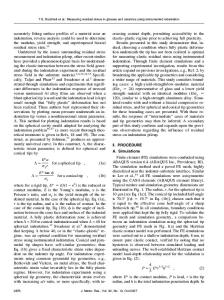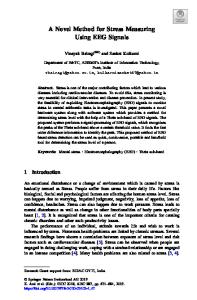Measuring Residual Stress on the Nanometer Scale - Novel Tools for Fundamental and Applied Research
- PDF / 245,642 Bytes
- 6 Pages / 432 x 648 pts Page_size
- 26 Downloads / 357 Views
Measuring Residual Stress on the Nanometer Scale - Novel Tools for Fundamental and Applied Research R. B. Wehrspohn1, M. Krause1, C. Schriever2 1 Fraunhofer Institute for Mechanics of Materials IWM, Walter-Huelse-Str.1, 06120 Halle, Germany 2 Martin-Luther-University Halle-Wittenberg, μMD Group/Institute of Physics, HeinrichDamerow-Str. 4, 06120 Halle, Germany
ABSTRACT In the present paper, strain measurements based on second harmonic generation (SHG) and electron backscatter diffraction (EBSD) is demonstrated via two illustrative applications. While SHG gains access to strains in buried interfaces, EBSD can be used to measure strains in crystalline thin films with high spatial resolution on the order of tens of nanometers and high surface sensitivity. In addition, target preparation using low-voltage ion beam milling is demonstrated, gaining access to unstrained sample positions in strained silicon on insulator (sSOI) systems which are necessary for common “pattern-shift” methodologies. INTRODUCTION Knowledge about stress and strain is essential for tailoring the mechanical and electronic properties of materials. In particular in case of nanostructures like thin layers, nanowires or nanoparticles, the ability to analyze their mechanical properties is of utmost relevance. In fact, due to the size reduction, high stresses can be localized in small volumes that might lead to unusual material properties on the one hand and failure of devices on the other hand. To date, the number of available stress measurement techniques is rather large. However, none of them is without shortcomings: either their resolution is too small, or they are destructive, often they have to go hand in hand with complex modeling, or they can be applied to a certain class of materials only. Thus, there is still a strong demand for novel techniques which can provide a means of determining local strains with high spatial resolution on the one hand and high strain sensitivity on the other hand. In the present paper, we will briefly summarize the present state of development for different competing strain measurement techniques. Afterwards we will demonstrate the potential of two novel techniques, notably second harmonic spectroscopy and electron backscatter diffraction combined with low voltage ion sputtering. STRESS MEASUREMENT ON THE NANOSCALE-PRESENT STATE The use of x-ray diffraction techniques to determine strain is well established. It has the distinct advantage of being both very accurate (strain sensitivity on the order of 10-4) and nondestructive. Micro-Laue x-ray diffraction allows the determination of strain tensor on a submicron scale in various materials [1]. Moreover, the resolution set by the beam size can be increased through the use of coherent diffraction, which may yield strain maps with a spatial resolution below 10 nm [2]. Within kinematic theory it is assumed that the diffraction pattern is the result of a simple Fourier-transform of a modified electron density. Because of the well
103
known “phase problem”, getting the str
Data Loading...











